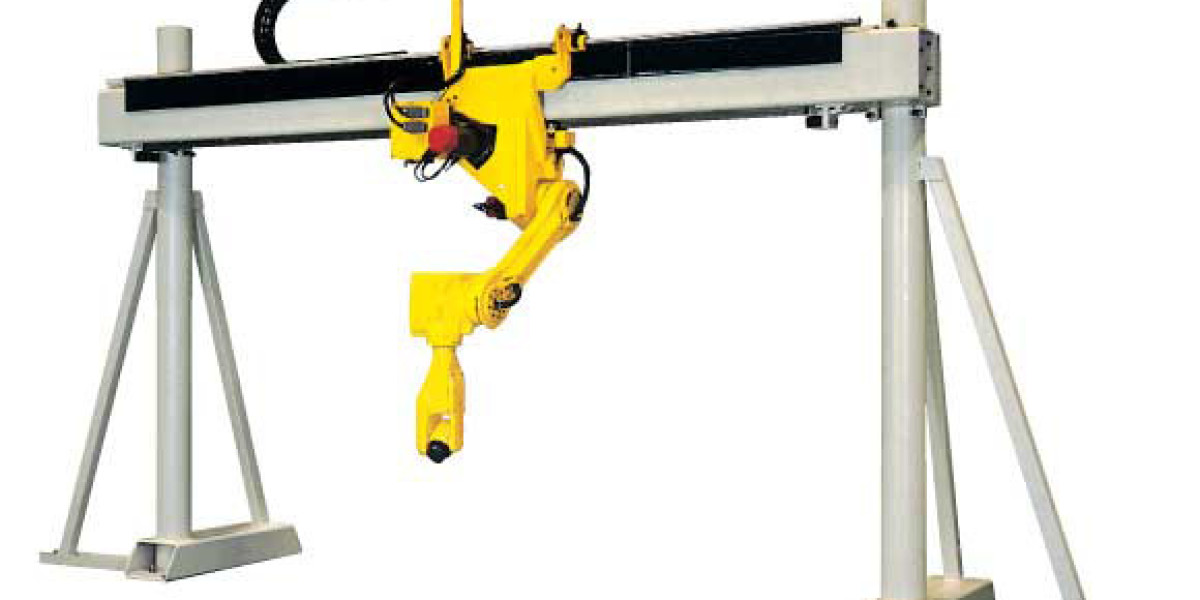The global market for gantry industrial robots was valued at approximately USD 3.52 billion in 2023. The industry is expected to grow at a compound annual growth rate (CAGR) of around 6.50% between 2024 and 2032, reaching an estimated value of USD 6.21 billion by 2032. This detailed article offers a deep dive into the market size, key benefits, industry developments, driving factors, COVID-19 impact, restraining factors, market segmentation, and regional insights, with a special focus on the industrial automation and equipment robotics and automation subcategory. Additionally, the article discusses key players, opportunities, challenges, and market scope while incorporating LSI (Latent Semantic Indexing) and long-tail keywords for optimal search engine visibility.
Market Overview
Gantry industrial robots, also known as Cartesian robots, are used in various industries for tasks that require precision, reliability, and efficiency. These robots operate on three linear axes (X, Y, and Z) and are commonly used in applications such as material handling, assembly, welding, packaging, and inspection. The market for gantry industrial robots is driven by the growing demand for automation in industries such as automotive, electronics, aerospace, and logistics.
Key Benefits of Gantry Industrial Robots
- High Precision and Accuracy: Gantry industrial robots offer exceptional precision and accuracy in performing repetitive tasks. This is particularly beneficial in industries such as electronics and aerospace, where even minor deviations can lead to significant issues.
- Flexibility in Applications: These robots are highly versatile and can be customized to handle a wide range of applications, from material handling to complex assembly processes. This flexibility makes them an attractive option for various industries.
- Enhanced Productivity: By automating repetitive and labor-intensive tasks, gantry robots significantly enhance productivity. They can operate continuously with minimal supervision, reducing the need for human intervention and increasing output.
- Cost-Effectiveness: Although the initial investment in gantry robots can be high, they offer long-term cost savings by reducing labor costs, minimizing errors, and improving efficiency.
- Scalability: Gantry robots can be easily scaled up or down to meet changing production needs. This scalability is essential for industries with fluctuating demand, allowing them to adjust their production capacity without significant investments.
Key Industry Developments
The gantry industrial robots market has witnessed several significant developments in recent years:
- Integration with Advanced Technologies: The integration of gantry robots with advanced technologies such as artificial intelligence (AI), machine learning, and the Internet of Things (IoT) has revolutionized the automation industry. These technologies enable predictive maintenance, real-time monitoring, and adaptive control, further enhancing the capabilities of gantry robots.
- Increased Adoption in the Automotive Industry: The automotive industry has been a major adopter of gantry industrial robots, using them for tasks such as welding, painting, and assembly. The demand for electric vehicles (EVs) has further fueled the adoption of automation in automotive manufacturing.
- Collaborative Robots (Cobots): The development of collaborative robots, or cobots, that can work alongside human operators is a notable trend in the industry. These robots are designed to be safe and user-friendly, allowing for closer collaboration between humans and machines.
- Sustainability Initiatives: Manufacturers are increasingly focusing on developing energy-efficient gantry robots that reduce power consumption and minimize environmental impact. This aligns with global sustainability goals and regulatory requirements.
Driving Factors
Several factors are driving the growth of the global gantry industrial robots market:
- Rising Demand for Automation: The increasing need for automation in various industries, driven by the desire to enhance productivity, reduce labor costs, and improve quality, is a key driver of the market. Gantry robots are particularly well-suited for tasks that require precision and consistency.
- Growth of the Manufacturing Sector: The expansion of the manufacturing sector, particularly in emerging economies, is fueling the demand for gantry robots. These robots are used in various manufacturing processes, from material handling to assembly, contributing to the sector’s growth.
- Technological Advancements: Continuous advancements in robotics technology, including the development of AI-powered robots and IoT-enabled systems, are driving the adoption of gantry robots. These innovations are improving the performance, reliability, and versatility of these robots.
- Increased Focus on Workplace Safety: Gantry robots help improve workplace safety by taking over hazardous tasks that pose risks to human workers. This is particularly important in industries such as chemicals, heavy machinery, and mining, where safety concerns are paramount.
Impact of COVID-19
The COVID-19 pandemic had a profound impact on the global gantry industrial robots market. The initial outbreak led to disruptions in supply chains, factory closures, and a decline in industrial production. However, the pandemic also highlighted the importance of automation in maintaining business continuity. As companies adapted to the new normal, there was a surge in demand for industrial robots to minimize human contact, ensure social distancing, and maintain production levels.
The pandemic accelerated the adoption of automation in industries such as logistics, pharmaceuticals, and food processing. As a result, the market for gantry industrial robots experienced a significant rebound post-2020, with companies investing in automation to enhance resilience and efficiency.
Restraining Factors
While the market for gantry industrial robots is poised for growth, it faces several challenges:
- High Initial Investment: The cost of acquiring and installing gantry robots can be prohibitively high for small and medium-sized enterprises (SMEs). This high initial investment remains a significant barrier to entry for many companies.
- Technical Complexity: The operation and maintenance of gantry robots require specialized skills and knowledge. This technical complexity can be a challenge for companies without the necessary expertise, leading to increased training and maintenance costs.
- Competition from Alternative Technologies: Gantry robots face competition from other automation technologies, such as articulated robots, SCARA robots, and delta robots. These alternatives may offer advantages in specific applications, limiting the adoption of gantry robots.
- Economic Uncertainty: Economic fluctuations and uncertainties, such as those caused by the COVID-19 pandemic, can impact capital investments in automation. Companies may delay or reduce spending on robotics during periods of economic instability.
Market Segmentation
The global gantry industrial robots market is segmented based on type, application, end-user, and region:
- By Type: The market is divided into 1-axis, 2-axis, 3-axis, and 4-axis gantry robots. The 3-axis segment holds the largest market share, driven by its widespread use in material handling, assembly, and packaging applications.
- By Application: The market is segmented into material handling, welding, assembly, packaging, and others. The material handling segment is the largest, driven by the need for efficient and precise movement of materials in manufacturing and logistics.
- By End-User: The market is segmented into automotive, electronics, aerospace, healthcare, and others. The automotive sector is the largest end-user segment, driven by the extensive use of gantry robots in tasks such as welding, painting, and assembly.
- By Region: The market is segmented into North America, Europe, Asia-Pacific, Latin America, and the Middle East and Africa. Asia-Pacific is the largest and fastest-growing market, driven by the expansion of the manufacturing sector in countries like China, Japan, and South Korea.
Market Outlook
The global gantry industrial robots market is expected to experience robust growth during the forecast period. The increasing demand for automation, coupled with advancements in robotics technology, will drive market expansion. Additionally, the growing focus on sustainability and the development of energy-efficient robots will provide new opportunities for market players.
Trends in the Gantry Industrial Robots Market
Several key trends are shaping the future of the gantry industrial robots market:
- Integration with AI and IoT: The integration of AI and IoT with gantry robots is a major trend in the industry. These technologies enable robots to perform more complex tasks, adapt to changing conditions, and provide real-time data for predictive maintenance and optimization.
- Collaborative Robots (Cobots): The development of collaborative gantry robots that can work alongside human operators is gaining traction. These cobots are designed to be safe, easy to program, and flexible, making them ideal for tasks that require human-robot collaboration.
- Focus on Energy Efficiency: Manufacturers are increasingly focusing on developing energy-efficient gantry robots that reduce power consumption and environmental impact. This trend is driven by the growing emphasis on sustainability and the need to comply with environmental regulations.
- Customization and Flexibility: The demand for customized and flexible automation solutions is increasing, particularly in industries with diverse production needs. Gantry robots are being designed to be easily reconfigured and adapted to different tasks, enhancing their versatility.
Industry Segmentation and Regional Analysis
The gantry industrial robots market can be broadly segmented into various categories based on type, application, and end-user. Each segment offers unique opportunities and challenges, with specific factors driving growth in different regions.
- North America: The market in North America is driven by the adoption of automation in industries such as automotive, electronics, and healthcare. The region is also witnessing increased investment in advanced robotics and AI technologies.
- Europe: In Europe, the market is influenced by stringent safety and environmental regulations, which are driving the adoption of energy-efficient and safe gantry robots. The region is also seeing increased adoption of collaborative robots in manufacturing and logistics.
- Asia-Pacific: Asia-Pacific is the largest and fastest-growing market for gantry industrial robots. The rapid expansion of the manufacturing sector in countries like China, Japan, and South Korea is driving demand for automation. The region is also a hub for robotics innovation and production.
- Latin America: The market in Latin America is primarily driven by the growth of the automotive and electronics industries. The region is also seeing increased investment in automation to enhance productivity and competitiveness.
- Middle East and Africa: The market in this region is growing due to the expansion of the oil and gas, and industrial sectors. The demand for reliable and efficient automation solutions is on the rise, particularly in industries with hazardous environments.
Subcategory: Industrial Automation and Equipment Robotics and Automation
The gantry industrial robots market is closely linked to the broader industrial automation and equipment robotics and automation industry. The demand for reliable and efficient automation solutions in industrial settings has led to increased investment in gantry robots. Key players in the robotics and automation sector are focusing on developing advanced gantry robots that can integrate seamlessly with other automation systems, improving efficiency and reducing operational costs.
Key Players in the Global Gantry Industrial Robots Market
Several key players dominate the global gantry industrial robots market. These companies are focusing on product innovation, strategic partnerships, and mergers and acquisitions to strengthen their market position. Some of the major players include:
- KUKA AG
- ABB Ltd.
- FANUC Corporation
- Yaskawa Electric Corporation
- Mitsubishi Electric Corporation
- Bosch Rexroth AG
- Parker Hannifin Corporation
- Güdel Group AG
- OMRON Corporation
- IAI Industrial Robots
Opportunities in the Market
The global gantry industrial robots market offers several opportunities for growth:
- Expansion in Emerging Markets: The growing need for automation in emerging markets presents significant opportunities for market expansion. These regions are investing in industrial automation to enhance productivity and competitiveness.
- Development of Collaborative Robots: The development of collaborative gantry robots that can work alongside human operators offers new opportunities for innovation and growth in the robotics industry.
- Integration with Advanced Technologies: The integration of gantry robots with AI, IoT, and machine learning technologies presents opportunities for the development of more intelligent and adaptive automation solutions.
Challenges in the Market
Despite the growth opportunities, the market faces several challenges:
- High Initial Investment: The high initial cost of acquiring and installing gantry robots remains a significant barrier to market growth, particularly for small and medium-sized enterprises (SMEs).
- Technical Complexity: The operation and maintenance of gantry robots require specialized skills and knowledge, which can be a challenge for companies without the necessary expertise.
- Economic Uncertainty: Economic fluctuations and uncertainties can impact capital investments in automation, leading to delays or reductions in spending on robotics.
Market Scope and Future Outlook
The global gantry industrial robots market is expected to continue its growth trajectory, driven by the increasing demand for automation and technological advancements. The market scope is broad, with applications in various sectors, including automotive, electronics, aerospace, and healthcare. As the industry evolves, key players will focus on innovation, sustainability, and expanding their presence in emerging markets.
The global gantry industrial robots market is poised for steady growth, driven by the rising demand for automation, advancements in robotics technology, and the increasing focus on sustainability. The market offers significant opportunities for expansion, particularly in emerging markets and the development of collaborative robots. However, challenges such as high initial costs and technical complexity must be addressed to ensure long-term success. By focusing on innovation, flexibility, and energy efficiency, companies can capitalize on the growing demand for gantry industrial robots in the years to come.








